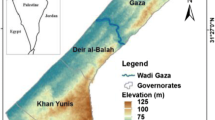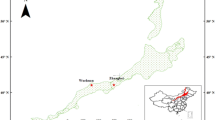Abstract
A study on evapotranspiration from potato fields was conducted in the Lower Gangetic Plains of India. The input data required for the CROPWAT irrigation management model was collected, and evapotranspiration (ET) and irrigation water requirement (IWR) for potato crops were calculated using the model. Firstly, the CROPWAT model was validated by comparing simulated crop evapotranspiration (SET) with actual ET calculated through the field water balance method. Thereafter, SET and IWR for nine locations in the lower Gangetic plains of India were calculated for the period from 1996–1997 to 2008–2009, for the current situation (using 20-year-average weather data of the stations), and for elevated thermal conditions, i.e. considering 2 and 3 °C increases over the current temperature. The future change in IWR for potato up to 2050 was also calculated considering the projected climatic scenario generated by the PRECIS model. The CROPWAT calculated IWR values showed an increasing, though not statistically significant, trend in requirement of irrigation water for potato across the nine locations during the period from 1996–1997 to 2008–2009. At a temperature increase of 2 °C over normal, the mean SET of potato would increase by 0.06 mm per day and the average IWR would be 6.0 mm per season more. If the mean temperature would be 3 °C more than normal, the SET would be 0.16 mm day−1 higher and the IWR 16.6 mm. Also based on the projected climatic scenario generated by the PRECIS model, the future SET up to 2050 showed an increasing trend. The present study indicates increasing demand for irrigation water, which may significantly affect the agricultural scenario in the region.






Similar content being viewed by others
References
Allen RG, Pruitt WO, Rase D, Smith M, Pereira LS (2005) Prediction accuracy for project-wise evapotranspiration using crop coefficients and reference evapotranspiration. J Irrig Drain Eng ASCE 131(1):24–36
Anonymous (2003) Double-transplanting of boro rice. In: Rice-wheat newsletter. Published by Rice-Wheat Consortium for the Indo-Gangetic Plains, an ecoregional program of CGIAR
AQUASTAT (2014) FAO’s information system on water and agriculture: general summary Asia. (http://www.fao.org/nr/water/aquastat/countries_regions/asia)
Barlow M, Clarke T (2003) Blue gold. Left world Books, New Delhi, pp 3–49
Boomiraj K, Chakrabarti B, Aggarwal PK, Choudhary R, Chander S (2010) Assessing the vulnerability of Indian mustard to climate change. Agric Ecosys Environ 138:265–273
Bruggeman AC, Mostaghimi S, Brannan KM (1999) A stochastic model for solute transport in macroporous soils. Trans ASAE 39(4):1379–1390
Carter TR, Saarikko RA, Niemi KJ (1996) Assessing the risks and uncertainties of regional crop potential under a changing climate in Finland. Agric Food Sci 5:329–350
Cavero J, Farre I, Debaeke P, Maci JM (2000) Simulation of maize yield under water stress with the EPIC phase and CROPWAT models. Agron J 92:679–690
Chattopadhyary N, Hulme M (1997) Evaporation and potential evaporation in India under conditions of recent and future climate change. Agric For Meteorol 87:55–73
CIP (2014) Report of international potato center. (http://cipotato.org/)
Clarke D, Smith M, El-Askari K (1998) CROPWAT for windows: user guide. University of Southampton
Darren TD, Kumar P, Stephen PL (2014) Simultaneous improvement in productivity, water use and albedo through crop structural modification. Glob Chang Biol. doi:10.1111/gcb.12567
Davies A, Jenkins T, Pike A, Shaq J, Carson I, Pollock CJ, Parry MI (1996) Modelling the predicted geographic and economic response of UK cropping systems to climate change scenarios: the case of potatoes. Asp Appl Biol 45:63–69
Droogers P, Immerzeel WW, Lorite IJ (2010) Estimating actual irrigation application by remotely sensed evapotranspiration observations. Agric Water Manag 97:1351–1359
FAO (1992) CROPWAT: a computer program for irrigation planning and management. Irrigation and Drainage Paper No. 46. Rome
FAOSTAT (2012) FAOSTAT agricultural production (www.faostat.fao.org/)
Fischer G, Francesco N, Van Velthuizen TH, Wiberg DA (2007) Climate change impacts on irrigation water requirements: effects of mitigation. Technol Forecast Soc Chang 74(7):1083–1107
Fleisher DH, Timlin DJ, Reddy VR (2006) Temperature influence on potato leaf and branch distribution and on canopy photosynthetic rate. Agron J 98:1442–1452
Franke L, Steyn M, Haverkort AJ (2014) Potato production in a changing climate II. What are the prospects for the Sandveld? CHIPS, p 38-41
Hanks RJ, Ashcroft GL (1980) Applied soil physics: soil water and temperature applications. Advanced series in agricultural review 8. Springer Verlag, New York
Haverkort AJ, Franke AC, Engelbrecht FA, Steyn JM (2013) Climate change and potato production in contrasting South African agro-ecosystems 1. Effects on land and water use efficiencies. Potato Res 56:31–50. doi:10.1007/s11540-013-9230-4
Hijmans RJ (2003) The effect of climate change on global potato production. Am J Potato Res 80:271–279
Hillel D (1971) Soil and water: physical principles and processes. Academic, New York
Horticulture Statistics Division (2016) State-wise analysis of Production, Storage, Market arrival and Price trends for Onion and Potato. (Website: nhm.nic.in/Archive/ICAR, accessed on 25.1.16).
IPCC (2007) Summary for policy makers. Climate Change 2007: the physical science basis. Contribution of Working Group I to the Fourth Assessment Report of the Intergovernmental Panel on Climate Change. In: Solomon S, Qin D, Manning M, Chen Z, Marquis M, Averyt KB, Tignor M, Miller HL (eds) Cambridge University Press, Cambridge, p 1-18
Jaggard KW, Qi A, Ober AA (2010) Possible changes to crop yield by 2050. Phil Trans R Soc Bot 365:2835–2851
Kiziloglu FM, Sahin U, Tunc T, Diler S (2006) The effect of deficit irrigation on potato evapotranspiration and tuber yield under cool season and Semiarid climatic conditions. Agron J 5(2):284–288
Ku SF, Shin-Shen H, Chen-Wuing L (2006) Estimation irrigation water requirements with derived crop coefficients for upland and paddy crops in ChiaNan Irrigation Association, Taiwan. Agric Water Manag 82:433–451
Lascano RJ (2000) A general system to measure and calculate daily crop water use. Agron J 92:821–832
Mall RK, Gupta A, Singh R, Singh RS, Rathore LS (2006) Water resources and climate change: An Indian perspective. Curr Sci 90(12):1610–1626
Naresh Kumar S, Govindakrishnan PM, Swarooparani DN, Nitin C, Surabhi J, Aggarwal PK (2015) Assessment of impact of climate change on potato and potential adaptation gains in the Indo-Gangetic Plains of India. Int J Plant Prod 9(1):151–170
Peiris DR, Crawford JW, Grashoff C, Jefferies RA, Parter JR, Marshall B (1996) A simulation study of crop growth and development under climate change. Agric For Meteorol 79:271–287
Rosenzweig C, Phillips J, Goldberg R, Carroll J, Hodges T (1996) Potential impacts of climate change on citrus and potato production in the US. Agric Syst 52(4):455–479
Rushton KR (2003) Groundwater hydrology: conceptual and computational models. Wiley, UK
Schewe J, Heinke J, Gerten D, Haddeland I, Arnell NW et al (2014) Multimodel assessment of water scarcity under climate change. PNAS 111(9):3245–3250. doi:10.1073/pnas.1222460110
Schiermeier Q (2014) Water risk as world warms. Nature 505:10–11
Sehgal JL, Mandal DK, Mnadal C, Vadivelu S (1990) Agro-ecolological regions ofIndia. NBSS publication: 24. National Bureau of Soil Survey and Land Use Planning (Indian Council of Agricultural Research), Nagpur
Shaw RJ, Thorburn PJ (1985) Towards a quantitative assessment of water quality for irrigation. In: Planning and management of water for agriculture in the tropics. Fifth Afro-Asian Regional Conference, Townsville, Australia. ICID (International Commission on Irrigation and Drainage). p 41-52
Singh LP, Parkash B, Singhvi AK (1998) Evolution of the Lower Gangetic Plain landforms and soils in West Bengal, India. Catena 33(2):75–104
Singh BP, Dua VK, Govindakrishnan PM, Sharma S (2013) Impact of climate change on potato. Climate-Resilient Horticulture: Adaptation and Mitigation Strategies, p 125-135. doi:10.1007/978-81-322-0974-4_12
Smith M (1992) CROPWAT—a computer program for irrigation planning and management. FAO Irrigation and Drainage paper 46
World Bank Group (2014) Water and climate change. (http://www.water.worldbank.org/)
Acknowledgments
The help and support from Director of Research, Bidhan Chandra Krishi Viswavidyalaya and Dr. M. Bose, Professor, Jadavpur University, are duly acknowledged. Mrs. Renaissance Banerjee helped a lot in editing the manuscript.
Author information
Authors and Affiliations
Corresponding author
Rights and permissions
About this article
Cite this article
Banerjee, S., Chatterjee, S., Sarkar, S. et al. Projecting Future Crop Evapotranspiration and Irrigation Requirement of Potato in Lower Gangetic Plains of India using the CROPWAT 8.0 Model. Potato Res. 59, 313–327 (2016). https://doi.org/10.1007/s11540-016-9327-7
Received:
Accepted:
Published:
Issue Date:
DOI: https://doi.org/10.1007/s11540-016-9327-7




